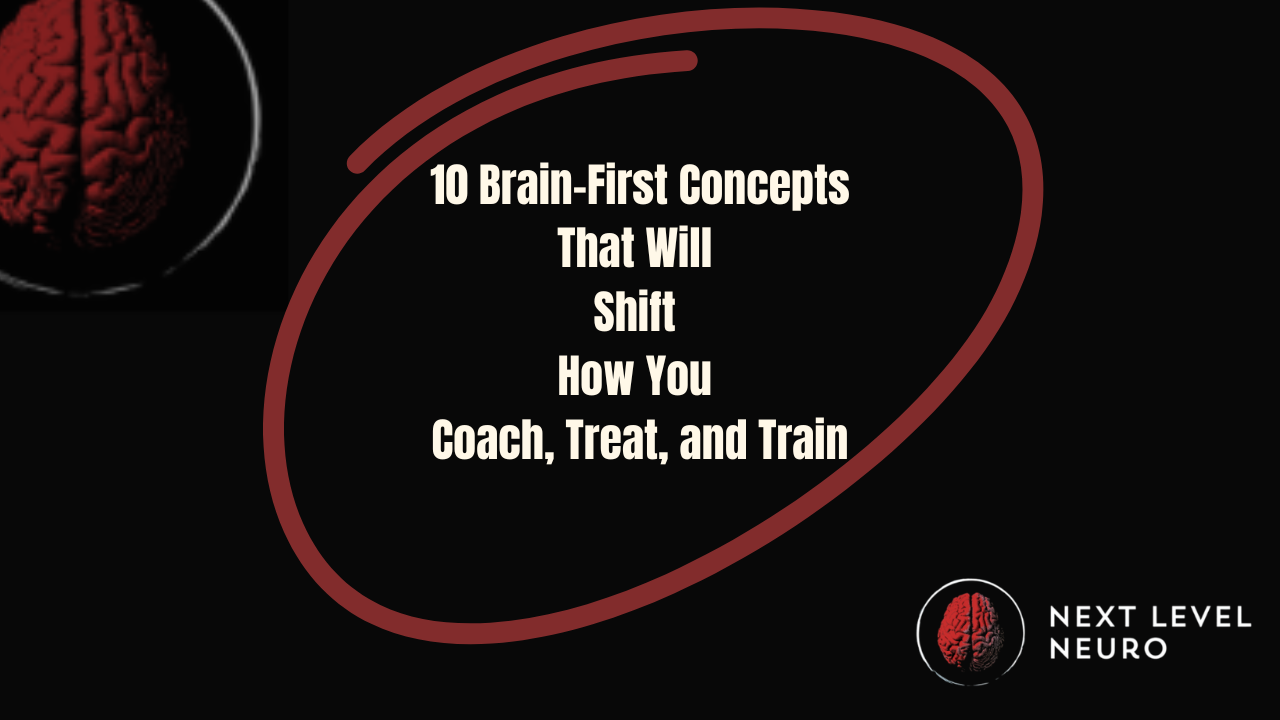10 Brain-First Concepts That Will Shift How You Coach, Treat, and Train
Apr 18, 2025
(Even If You’ve Never Studied Neurology Before)
The Missing Piece Behind Client Plateaus and Unpredictable Results
If you’ve been in the game long enough—whether you’re coaching strength, treating pain, helping someone recover from trauma, or teaching movement—you’ve seen it:
- The client who does everything right and still gets dizzy every time they try to train.
- The athlete who keeps hitting a fatigue wall they can’t outwork.
- The chronic pain case where no soft tissue release, no stability drill, no mobility plan sticks for long.
It’s frustrating.
But it’s not your fault.
You’ve been given incredible tools.
But you weren’t given the operating system those tools run on: the brain.
Applied Neurology doesn’t throw out the protocols you know—it explains why they sometimes fail and gives you a way to turn them back on.
Applied Neurology doesn’t replace your current approach; it enhances it.
The quotes below are pulled from the NLN Mentorship lessons and highlight key concepts that coaches and therapists often miss—not because they don’t care, but because the neuro lens is rarely taught in traditional training models.
These aren’t just inspirational.
They’re practical.
They’re the kind of truths that can rewire how you see your client’s fatigue, tension, dysfunction, or stuckness.
10 Brain-First Concepts That Will Shift How You Coach, Treat, and Train
1. "Tension is the nervous system's go-to protective mechanism. Before your brain even knows what the threat is, it tells your body: clench, guard, brace."
Translation: What you think is tight may actually be a protective mechanism. Stretching it might make it worse.
2. "These exercises aren’t therapy—they’re training. We’re training your brain to get back online and talk to the body again."
Translation: Don’t just treat symptoms—restore communication.
3."Pain, fatigue, dizziness, tightness—they’re not dysfunctions. They’re your nervous system’s way of saying: ‘Hey, I’m not safe right now.’"
Translation: What if your client isn’t broken? What if they’re just being protected?
4. "The midbrain controls fuel delivery to your muscles. When it’s offline, movement feels heavy, exhausting, or overwhelming—because your body isn’t getting the blood and oxygen it needs."
Translation: If your client can’t “push through,” maybe it’s a fuel problem, not a mindset one.
5. "If you’ve had dizziness, visual issues, or facial numbness—those are signs that your vestibular system and cranial nerves in the pons have taken a hit."
Translation: Dizziness isn't always inner ear—it’s often a brainstem communication issue.
6. "Facial movement. Eye motion. Chewing. Swallowing. Breathing. These are real-life functions we can train by activating cranial nerves."
Translation: Functional neurology is real-world relevant. It’s not just brain games.
7. "The more your brain perceives threat—from the environment, from memory, from the body—the more it clamps down on movement, breath, and cognition."
Translation: Brains don’t guess—they predict. And their predictions shape how the whole body behaves.
8. "The brain doesn’t care about your workout plan. It cares about safety. Until it feels safe, performance is off the table."
Translation: First, earn safety. Then earn strength, mobility, and recovery.
9. "You might do a vision drill, and suddenly your shoulder moves better. Not because vision controls the shoulder—but because the threat load came down."
Translation: Neurology isn’t linear. It’s layered. That’s the magic—and the mystery—of brain-first work.
10. "We’re not repairing the brain with surgery. We’re using input—breath, vision, movement—to rebuild the communication network."
Translation: Small inputs can create big shifts when they reach the right part of the brain.
Brain First Isn’t Just Smart—It’s Necessary
What makes this different isn’t the science (even though it’s solid).
It’s the application.
At Next Level Neuro, we’re not teaching theory for theory’s sake.
We’re giving you tools you can use right now—whether you’re a therapist, personal trainer, a massage therapist, a movement coach, or someone who just wants to help people feel better and move better.
This is where coaching and care get neuro-integrated.
Where results get more reliable.
And where your toolbox stops feeling like guesswork.
Ready to explore how to bring this to life in your own practice?
Want to learn our exact framework on how we integrate neurology with every single client?
Watch our free live workshop on our applied neurology frameworks. We are giving away our process. Click here or explore the full mentorship here.
Want more information on our Mentorship and Programs?
We hate SPAM. We will never sell your information, for any reason.

